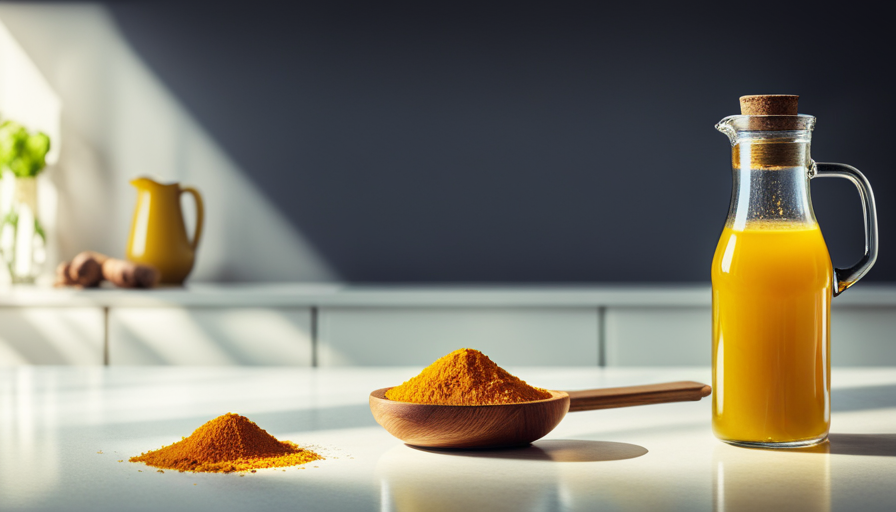Are you interested in the advantages of consuming turmeric with water or milk? Allow me to inform you that adding this golden spice to your daily regimen can greatly benefit your health. Turmeric has been utilized for ages in traditional medicine due to its potent anti-inflammatory and antioxidant qualities.
But can you really drink turmeric with water or milk? The answer is a resounding yes! Turmeric can be easily mixed with water or milk to create a delicious and nutritious beverage. Whether you prefer a simple turmeric-infused water or a creamy turmeric latte, there are plenty of options to suit your taste.
Not only does turmeric add a vibrant color to your drinks, but it also provides a plethora of health benefits. So, let’s dive deeper into the world of turmeric and discover the best ways to enjoy its goodness.
Key Takeaways
- Turmeric with water aids in digestion and detoxification.
- Turmeric and milk can have positive effects on the skin, reducing blemishes and moisturizing.
- Regular consumption of turmeric latte can provide anti-inflammatory and antioxidant properties.
- Choosing between turmeric water and golden milk depends on personal preference and health goals.
Health Benefits of Turmeric
Did you know that drinking turmeric with water or milk can provide numerous health benefits? Turmeric is a spice that’s been used for centuries in traditional medicine and cooking, and it’s known for its anti-inflammatory properties. Curcumin, the active compound in turmeric, has been shown to reduce inflammation in the body, which can help alleviate symptoms of conditions such as arthritis and inflammatory bowel disease.
In addition to its anti-inflammatory properties, turmeric has also been linked to weight loss. Studies have shown that curcumin can help regulate metabolism and reduce the accumulation of fat in the body. This can be especially beneficial for those who’re looking to shed a few pounds or maintain a healthy weight.
Drinking turmeric with water or milk is a simple and practical way to incorporate this spice into your daily routine. You can start by adding a teaspoon of turmeric powder to a glass of warm water or milk and stirring well. You can also enhance the flavor by adding a pinch of black pepper or honey.
In the next section, we’ll explore the benefits of drinking turmeric with water and how it can improve your overall health.
Turmeric and Water
Drinking turmeric with water is a simple and convenient way to enjoy its health benefits. It not only requires minimal preparation, but it also provides hydration benefits that can contribute to overall well-being. Additionally, consuming turmeric with water can aid in improved digestion and detoxification. This makes it a practical choice for those looking to support their digestive health.
Easy preparation and consumption
Turmeric can be easily prepared and enjoyed by mixing it with water or milk, making it a simple and convenient way to incorporate this beneficial spice into your daily routine. When preparing turmeric with water, you can simply add a teaspoon of turmeric powder to a glass of warm water and stir until well blended. If you prefer a creamier taste, you can mix turmeric powder with warm milk instead.
As for the dosage, it’s generally recommended to consume about 1-2 grams of turmeric per day, which is equivalent to ½ to 1 teaspoon. However, it’s always best to consult with a healthcare professional to determine the ideal dosage for your specific needs.
By incorporating turmeric into your daily routine, you can enjoy its numerous health benefits, including its potential to promote hydration and overall well-being.
Hydration benefits
To truly experience the hydrating benefits of incorporating turmeric into your daily routine, imagine the refreshing sensation of quenching your thirst on a hot summer day with a cool and revitalizing elixir. Turmeric offers numerous hydration benefits that can support your overall well-being.
Here are three ways turmeric can enhance your hydration levels:
-
Increased water absorption: Turmeric contains curcumin, a compound that’s been shown to improve water absorption in the body. This means that drinking turmeric-infused water can help your body effectively absorb and utilize the water you consume.
-
Electrolyte balance: Turmeric is rich in potassium, an essential electrolyte that helps regulate fluid balance in the body. Adequate potassium levels are crucial for maintaining proper hydration.
-
Anti-inflammatory properties: Turmeric possesses powerful anti-inflammatory properties, which can help reduce inflammation in the body. By reducing inflammation, turmeric can support optimal hydration levels.
Incorporating turmeric into your daily routine can not only enhance your hydration but also improve digestion and detoxification.
[Transition sentence into the subsequent section about ‘improved digestion and detoxification’]Improved digestion and detoxification
Imagine the incredible benefits your body could experience by incorporating turmeric into your daily routine – improved digestion and detoxification await!
Turmeric has long been used in traditional medicine for its digestive benefits. It contains an active compound called curcumin, which has been shown to stimulate the production of bile in the liver. Bile plays a crucial role in breaking down fats and aiding in digestion. Additionally, curcumin has been found to have anti-inflammatory properties that can help reduce inflammation in the digestive system and promote better gut health.
Furthermore, turmeric has been shown to support detoxification processes in the body. It helps to enhance liver function and increase the production of enzymes that assist in detoxifying harmful substances. So, incorporating turmeric into your daily routine can lead to improved digestion and detoxification.
Now, let’s explore the benefits of combining turmeric with milk.
Turmeric and Milk
You can combine the power of turmeric and the creaminess of milk to create a golden elixir. Turmeric has been used for centuries for its numerous health benefits, and when mixed with milk, it becomes even more potent.
Firstly, turmeric is known for its anti-inflammatory properties, and when consumed with milk, it can help soothe inflammation in the digestive system. This can be particularly beneficial for those with digestive issues such as bloating or indigestion. Additionally, turmeric can aid in detoxification by supporting the liver’s natural detox process. Milk acts as a carrier for turmeric, allowing it to be easily absorbed by the body.
Furthermore, combining turmeric and milk can have positive effects on the skin. Turmeric has been used in skincare for its ability to reduce blemishes and promote a healthy complexion. Milk, on the other hand, contains lactic acid, which can exfoliate and moisturize the skin. By combining these two ingredients, you can create a nourishing face mask or a soothing bath soak.
Incorporating turmeric and milk into your daily routine can have numerous benefits for digestion, detoxification, and skincare. Now, let’s move on to a delicious turmeric latte recipe that you can easily make at home.
Turmeric Latte Recipe
I love making turmeric lattes because they’re not only delicious but also packed with health benefits. To make a turmeric latte, you’ll need ingredients like turmeric powder, milk (dairy or plant-based), sweetener of your choice, and a pinch of black pepper. Simply heat the milk, add the turmeric powder, sweetener, and black pepper, and whisk until well blended.
There are many variations and customization options for turmeric lattes. You can add other spices like cinnamon or ginger for added flavor and health benefits. You can also experiment with different types of milk or sweeteners to suit your taste preferences.
To maximize the health benefits of turmeric latte, make sure to use high-quality turmeric powder that contains a good amount of curcumin, the active compound in turmeric. Adding a pinch of black pepper helps with the absorption of curcumin. Also, remember to consume turmeric latte regularly to experience its anti-inflammatory and antioxidant properties.
Ingredients and preparation
To add a little extra flavor and creaminess, try mixing turmeric with either water or milk. Turmeric has numerous health benefits, including its anti-inflammatory properties and its ability to boost the immune system. By incorporating it into your daily routine, you can reap the benefits of this powerful spice.
There are various turmeric recipes available, but a simple and effective way to consume it is by making a turmeric latte. To prepare this drink, start by heating up water or milk in a saucepan. Add a teaspoon of turmeric powder and stir well. You can also add other spices like cinnamon or ginger to enhance the flavor. Finally, strain the mixture and serve it hot.
This turmeric latte is a delicious and nutritious way to incorporate turmeric into your diet.
Moving on to variations and customization options, there are several ways to personalize your turmeric latte to suit your taste preferences.
Variations and customization options
For those looking to add a little extra flair to their turmeric latte, consider experimenting with a medley of aromatic spices like cinnamon and ginger, transforming your humble beverage into a warm and comforting elixir that will transport you to exotic lands. Variations and customization options allow you to tailor your turmeric drink to your taste preferences and health needs.
Here are some ideas to get you started:
| Variation | Ingredients | Benefits |
|---|---|---|
| Golden Milk | Turmeric, milk, honey, black pepper | Anti-inflammatory, immune-boosting |
| Turmeric Tea | Turmeric, ginger, lemon, honey | Digestive health, antioxidant |
| Turmeric Smoothie | Turmeric, banana, spinach, almond milk | Energy-boosting, anti-inflammatory |
These variations not only provide a different flavor profile but also offer various health benefits. Incorporating turmeric into your daily routine can help reduce inflammation, improve digestion, and boost your immune system. To maximize the health benefits of turmeric, stay tuned for tips in the next section on how to enhance its absorption and bioavailability.
Tips for maximizing health benefits
If you’re truly serious about reaping all the amazing health benefits from your turmeric concoction, pay close attention to these expert tips.
To maximize absorption of turmeric’s beneficial compounds, it’s important to consume it with black pepper or a fat source such as coconut oil. Black pepper contains piperine, a compound that enhances turmeric’s absorption in the body. Additionally, turmeric is fat-soluble, so pairing it with a healthy fat like coconut oil can improve its absorption.
It’s also important to note that turmeric may have potential side effects, especially when consumed in large amounts or for extended periods of time. These can include stomach upset, diarrhea, and allergic reactions. To minimize the risk of side effects, it’s best to stick to moderate amounts and consult with a healthcare professional if you have any concerns.
Now, let’s explore the benefits of turmeric supplements.
Turmeric Supplements
Turmeric supplements are available in various forms, such as capsules or tablets. These supplements are a convenient way to incorporate turmeric into your daily routine, especially if you don’t enjoy the taste of turmeric in food or drinks.
When taking turmeric supplements, it’s important to follow the recommended dosage instructions provided by the manufacturer. This ensures that you’re getting the right amount of turmeric for maximum health benefits.
However, it’s also important to be aware of potential side effects when taking turmeric supplements. While turmeric is generally considered safe for most people, some individuals may experience digestive issues or allergic reactions. It’s always a good idea to consult with a healthcare professional before adding any new supplement to your routine, especially if you have any pre-existing medical conditions or are taking other medications.
Now, let’s transition into the next section about turmeric golden milk. This delicious beverage combines turmeric with milk, providing a soothing and nourishing drink that’s packed with health benefits.
Turmeric Golden Milk
Imagine yourself in a cozy setting, savoring a warm, golden elixir that holds the secret to improved well-being and a vibrant life. This magical potion, known as turmeric golden milk, has gained popularity in recent years for its numerous health benefits. Made by combining turmeric with milk, this ancient Ayurvedic drink is not only delicious but also packed with nutrients that can boost your overall health.
As you sip on your turmeric latte, you can’t help but feel the warmth spreading throughout your body. The combination of turmeric and milk creates a soothing and comforting beverage that is perfect for relaxing after a long day. But it’s not just the taste that makes this drink special; it’s the powerful medicinal properties of turmeric.
Turmeric is known for its anti-inflammatory and antioxidant properties, which can help reduce inflammation in the body and protect against oxidative damage. It also contains a compound called curcumin, which has been shown to have a wide range of health benefits, including improving brain function, reducing the risk of chronic diseases, and even potentially fighting cancer.
To give you a visual representation of the goodness of turmeric golden milk, imagine a table with three columns and four rows. In the first column, you have a cup of warm milk, while the second column showcases a vibrant yellow hue of turmeric. In the third column, you see a list of benefits such as reduced inflammation, improved brain function, and enhanced immune system. The fourth column highlights the importance of turmeric supplements in providing a concentrated dose of curcumin.
As you finish your turmeric latte, you can’t help but wonder what other wonders this incredible spice holds. Transitioning into the next section about turmeric tea, let’s explore another delightful way to incorporate this golden gem into your daily routine.
Turmeric Tea
As you dive into the world of turmeric tea, let the warm and earthy aroma embrace your senses, inviting you to experience a soothing and revitalizing journey.
Turmeric tea is not only a delicious beverage but also offers numerous health benefits. Known for its active compound called curcumin, turmeric has powerful anti-inflammatory and antioxidant properties. Consuming turmeric tea can help reduce inflammation in the body, support digestion, boost the immune system, and improve brain health.
To make a simple turmeric tea, you’ll need 1 teaspoon of ground turmeric, 1/4 teaspoon of ground black pepper (to enhance curcumin absorption), 1 tablespoon of honey or maple syrup (optional for sweetness), and 2 cups of water. Start by bringing the water to a boil and then add the turmeric and black pepper. Let it simmer for about 10 minutes, strain the tea, and sweeten it with honey or maple syrup if desired.
Sip on this warm and comforting tea to reap its wonderful benefits. The subtle spiciness and earthy flavor will surely delight your taste buds.
As you continue your journey to explore the wonders of turmeric, let’s now move on to the next section about turmeric smoothies and juices, where we’ll discover more delightful and nutritious ways to incorporate turmeric into our daily routine.
Turmeric Smoothies and Juices
Blend together your favorite fruits and vegetables with a dash of this vibrant spice for a refreshing and nutritious boost. Turmeric smoothie recipes are a great way to incorporate the health benefits of turmeric into your daily routine. Not only do these smoothies taste delicious, but they also provide a wide range of nutrients and antioxidants.
One popular turmeric smoothie recipe is the Turmeric Mango Smoothie. Simply blend together one ripe mango, a teaspoon of turmeric powder, a handful of spinach, a cup of almond milk, and a squeeze of lemon juice. This smoothie is not only packed with vitamins and minerals, but it also has anti-inflammatory properties thanks to the turmeric.
Another option is turmeric juice, which offers similar benefits in a different form. To make turmeric juice, combine fresh turmeric root with your choice of fruits and vegetables, such as oranges, carrots, and ginger. This juice is rich in antioxidants and can help support a healthy immune system.
Incorporating turmeric smoothies and juices into your diet is a simple and delicious way to enjoy the numerous health benefits of turmeric. Now, let’s move on to exploring how turmeric can be used in cooking and recipes, adding a burst of flavor and color to your favorite dishes.
Turmeric in Cooking and Recipes
To incorporate turmeric into your cooking and recipes, you’ll love the warm and earthy flavor it adds to soups, stews, and curries. Not only does turmeric provide a delicious taste, but it also offers a range of health benefits. Turmeric has long been used in traditional medicine for its anti-inflammatory properties and potential to improve digestion. Additionally, it is believed to help promote healthy skin due to its antioxidant and antimicrobial effects.
When it comes to incorporating turmeric into your cooking, the possibilities are endless. You can add a pinch of turmeric powder to your favorite soup or stew for a subtle flavor enhancement. For a more pronounced taste, try using turmeric in marinades for meat or vegetables. One popular way to enjoy turmeric is by making golden milk, a warm and comforting beverage made with turmeric, milk, and spices like cinnamon and ginger.
Here’s a table to give you some ideas on how to use turmeric in your cooking:
| Dish | How to Use Turmeric |
|---|---|
| Soup | Add a pinch of turmeric powder to your soup base |
| Curry | Use turmeric as one of the main spices in your curry |
| Smoothie | Blend turmeric with fruits and vegetables |
| Rice | Cook rice with turmeric for a vibrant color |
In the next section, we will discuss choosing the best option for you when it comes to incorporating turmeric into your daily routine.
Choosing the Best Option for You
If you’re looking to enhance your meals and improve your overall well-being, discovering the perfect way to incorporate the powerful benefits of turmeric into your daily routine can be a game-changer.
When it comes to choosing the best option for consuming turmeric, there are a few factors to consider.
Firstly, drinking turmeric with water is a simple and effective way to reap its health benefits. Turmeric contains a compound called curcumin, which has strong antioxidant and anti-inflammatory properties. Drinking turmeric water can help reduce inflammation in the body, support digestion, and boost immunity. It’s also a great option for those who prefer a lighter and more refreshing taste.
On the other hand, drinking turmeric with milk, commonly known as golden milk, is another popular choice. Milk helps to enhance the absorption of curcumin, making it more bioavailable to the body. Additionally, milk adds a creamy and comforting element to the drink. Golden milk is often enjoyed before bed as it can promote relaxation and improve sleep quality.
Ultimately, whether you choose to drink turmeric with water or milk depends on your personal preference and health goals. Both options provide the same health benefits, so it’s a matter of finding what works best for you. Experiment with different recipes and methods to discover your favorite way to incorporate this powerful spice into your daily routine.
Frequently Asked Questions
Can turmeric be consumed in the form of capsules or tablets?
Yes, turmeric can be consumed in the form of capsules or tablets. Turmeric supplements are a convenient way to incorporate turmeric into your daily routine, as they provide a standardized dosage of curcumin, the active compound in turmeric. The recommended turmeric dosage varies depending on the individual and the specific health condition being targeted. It’s important to follow the instructions on the supplement packaging and consult with a healthcare professional for personalized advice.
Is it safe to drink turmeric milk during pregnancy?
During pregnancy, it’s generally safe to drink turmeric milk in moderation. It’s been found that consuming turmeric during pregnancy can help reduce the risk of gestational diabetes by up to 50%. Turmeric is a natural anti-inflammatory and antioxidant, which can support a healthy pregnancy. However, it’s important to consult with your healthcare provider before making any dietary changes. Additionally, incorporating turmeric in cooking can provide similar benefits as drinking turmeric tea.
Can turmeric be used topically for skin conditions?
Turmeric can indeed be used topically for various skin conditions. One popular way to use it is by making a turmeric face mask. Turmeric contains a compound called curcumin, which has anti-inflammatory and antioxidant properties. This can help reduce inflammation and redness associated with acne. Additionally, curcumin may also have antimicrobial effects, which can help fight off acne-causing bacteria. However, it’s important to do a patch test first and consult with a dermatologist if you have any concerns.
How much turmeric should I consume daily to experience its health benefits?
To experience the health benefits of turmeric, it’s recommended to consume a daily dosage of 500 to 2,000 milligrams of curcumin, the active compound in turmeric. Studies have shown that curcumin has anti-inflammatory and antioxidant properties, which can help reduce the risk of chronic diseases. However, it’s important to note that individual needs may vary, and it’s always best to consult with a healthcare professional for personalized advice on turmeric supplementation.
Are there any side effects or interactions associated with turmeric consumption?
There are potential side effects and interactions associated with turmeric consumption. Turmeric may interact with certain medications, such as blood thinners, and could increase the risk of bleeding. It may also cause digestive issues, such as stomach upset or diarrhea, in some individuals. It’s important to consult with a healthcare professional before incorporating turmeric into your diet, especially if you’re taking any medications or have digestive health concerns.
Conclusion
In conclusion, incorporating turmeric into your daily routine can bring numerous health benefits. Whether you choose to drink it with water or milk, the powerful compounds in turmeric can help reduce inflammation, improve digestion, and boost your immune system.
Remember the old adage, "An ounce of prevention is worth a pound of cure." By adding turmeric to your diet, you can take proactive steps towards better health. So go ahead, try a turmeric latte, tea, smoothie, or add it to your favorite recipes. The choice is yours, but the benefits are undeniable.










